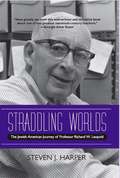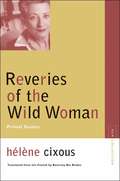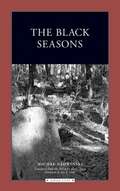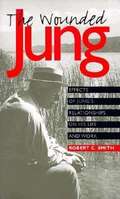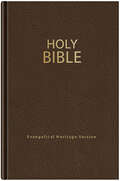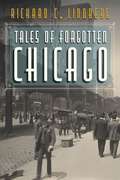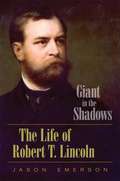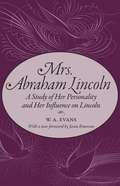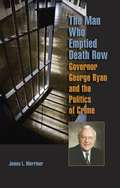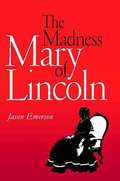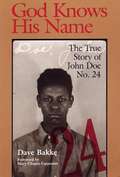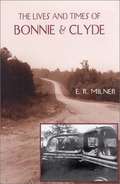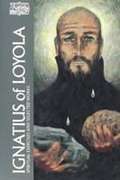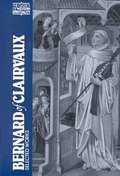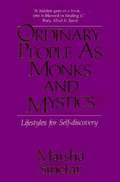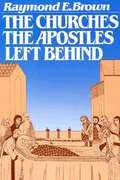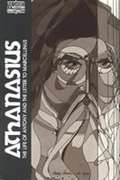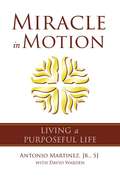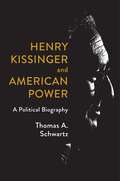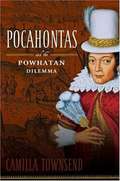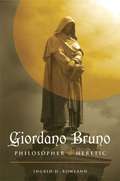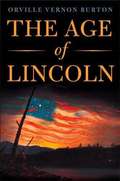- Table View
- List View
Straddling Worlds: The Jewish-American Journey of Professor Richard W. Leopold
by Steven J. HarperRichard W. Leopold was an historian of American foreign policy and professor at Northwestern University. While his books and articles are still relevant, his greatest legacy was as an influence on three generations of students, some of whom, like George McGovern and Richard Gephart, went on to help form foreign policy. One of those students, attorney Steven Harper, has drawn on Leopold's private papers, published works, interviews of Leopold and his own memories, to produce a loving biography of his former professor. More than a tribute, the book is also the story of the last century in America and the experience of a non-practicing Jew caught between total assimilation and anti-semitism. Annotation ©2008 Book News, Inc., Portland, OR (booknews.com)
Reveries of the Wild Woman
by Hélène Cixous Beverley Bie BrahicBorn to an Algerian-French father and a German mother, both Jews, Hélène Cixous experienced a childhood fraught with racial and gender crises. In this moving story she recounts how small domestic events - a new dog, the gift of a bicycle - reverberate decades later with social and psychological meaning. The story's protagonist, whose life resembles that of the author, endures a double alienation: from Algerians because she is French and from the French because she is Jewish. The isolation and exclusion Cixous and her family feel, especially under the Vichy government and during the Algerian War of independence, underpin this heartbreaking but also warmly human and often funny story. The author-narrator concedes that memories of Algeria awaken in her longings for the sights, sounds, and smells of her home country and ponders how that stormy relationship has influenced her life and thought. A meditation on postcolonial identity and gender, Reveries of the Wild Woman is also a poignant recollection of how childhood is author to the woman.
The Black Seasons
by Michal GlowinskiA mosaic of memories from a childhood in the Warsaw Ghetto and a life in hiding on the other side of the wall When six-year-old Michal Glowinski first heard the adults around him speak of the ghetto, he understood only that the word was connected with moving-and conjured up a fantastical image of a many-storied carriage pulled through the streets by some umpteen horses. He was soon to learn that the ghetto was something else entirely. A half-century later, Glowinski, now an eminent Polish literary scholar, leads us haltingly into Nazi-occupied Poland. Scrupulously attentive to the distance between a child's experience and an adult's reflection, Glowinski revisits the images and episodes of his childhood: the emaciated violinist playing a Mendelssohn concerto on the ghetto streets; his game of chess with a Polish blackmailer threatening to deliver him to the Gestapo; and his eventual rescue by Catholic nuns in an impoverished, distant convent. In language at once spare and eloquent, Glowinski explores the horror of those years, the fragility of existence, and the fragmented nature of memory itself.
The Wounded Jung: Effects of Jung's Relationships on His Life and Work
by Robert C. SmithShows how Jung's interest in the healing of the psyche was rooted in the conflicts of his own childhood. Explores his relationships with his parents, with Freud, and with the various women in his life and showing how they influenced his ideas on religion, alchemy, psychology as myth, and the reinterpretation of evil. Based on archival sources, interviews with Jung's intimates, and correspondence. For those interested in the connection between psychology and religion. Annotation c. by Book News, Inc., Portland, Or.
Holy Bible (EHV): Evangelical Heritage Version
by The Wartburg ProjectWhat is the Bible all about? There's no better answer than letting the Bible speak for itself. The Bible is all about God's awesome love for you and all people and what he has done for you through his Son, Jesus! There are many Bible translations out there for you to choose from. The Holy Bible: Evangelical Heritage Version (EHV) is translated faithfully from the original Hebrew and Greek languages. The expressions, imagery, and style of the original texts are all present—giving you an enduring picture of God's love that you can share with others. To help you get the most out of your Bible study, the Holy Bible: EHV includes: Brief introductions for each book Topical section headings Footnotes for deeper understanding References to parallel passages References to Old Testament quotations Both fresh and familiar to Christian readers and suitable for all-purpose uses in the church, the readable style of the EHV will help Christians new and old understand clearly what God is saying to you through his Word!
Tales of Forgotten Chicago
by Richard C. LindbergContains twenty-one fascinating, little-known stories about Chicago and its people. Spanning the Civil War through the 1960s, the volume showcases forgotten crimes, punishments, and consequences: poisoned soup that nearly killed three hundred leading citizens; a woman in showbiz and her street-thug husband whose checkered lives inspired a 1955 James Cagney movie; and the first police woman in Chicago, hired as a result of the senseless killing of a young factory girl in a racially tinged case of the 1880s. Also included are tales of industry and invention, such as America's first automobile race, the haunting of a wealthy Gilded Age manufacturer's mansion, and the identity of the telephone's rightful inventor. Chapters on the history of early city landmarks spotlight the fitht to save Lakefront Park and how "Lucky" Charlie Weeghman's northside baseball park became Wrigley Field. Other chapters explore civic, cultural, and political happenings, and some are just wonderful tales, such as a touching story about the sinking of Chicago's beloved Christmas tree ship. The final story describes the start of the Special Olympics which began in Chicago. RICHARD C. LINDBERG is an award-winning author, journalist, and lecturer who has written nineteen other books about Chicago history, politics, criminal justice, sports, and ethnicity. The 2011 memoir of his Northwest Side boyhood Whiskey Breakfast: My Swedish Family, My American Life, was named nonfiction book of the year by the Chicago Writer's Association.
Giant in the Shadows: The Life of Robert T. Lincoln
by Jason EmersonAlthough he was Abraham and Mary Lincoln’s oldest and last surviving son, the details of Robert T. Lincoln’s life are misunderstood by some and unknown to many others. Nearly half a century after the last biography about Abraham Lincoln’s son was published, historian and author Jason Emerson illuminates the life of this remarkable man and his achievements in Giant in the Shadows: The Life of Robert T. Lincoln. Emerson, after nearly ten years of research, draws upon previously unavailable materials to offer the first truly definitive biography of the famous lawyer, businessman, and statesman who, much more than merely the son of America’s most famous president, made his own indelible mark on one of the most progressive and dynamic eras in United States history. Born in a boardinghouse but passing his last days at ease on a lavish country estate, Robert Lincoln played many roles during his lifetime. As a president’s son, a Union soldier, an ambassador to Great Britain, and a U.S. secretary of war, Lincoln was indisputably a titan of his age. Much like his father, he became one of the nation’s most respected and influential men, building a successful law practice in the city of Chicago, serving shrewdly as president of the Pullman Car Company, and at one time even being considered as a candidate for the U.S. presidency. Along the way he bore witness to some of the most dramatic moments in America’s history, including Robert E. Lee’s surrender at Appomattox Courthouse; the advent of the railroad, telephone, electrical, and automobile industries; the circumstances surrounding the assassinations of three presidents of the United States; and the momentous presidential election of 1912. Giant in the Shadows also reveals Robert T. Lincoln’s complex relationships with his famous parents and includes previously unpublished insights into their personalities. Emerson reveals new details about Robert’s role as his father’s confidant during the brutal years of the Civil War and his reaction to his father’s murder; his prosecution of the thieves who attempted to steal his father’s body in 1876 and the extraordinary measures he took to ensure it would never happen again; as well as details about the painful decision to have his mother committed to a mental facility. In addition Emerson explores the relationship between Robert and his children, and exposes the actual story of his stewardship of the Lincoln legacy—including what he and his wife really destroyed and what was preserved. Emerson also delves into the true reason Robert is not buried in the Lincoln tomb in Springfield but instead was interred at Arlington National Cemetery. Meticulously researched, full of never-before-seen photographs and new insight into historical events, Giant in the Shadows is the missing chapter of the Lincoln family story. Emerson’s riveting work is more than simply a biography; it is a tale of American achievement in the Gilded Age and the endurance of the Lincoln legacy.
Mrs. Abraham Lincoln: A Study of Her Personality and Her Influence on Lincoln
by W. A. EvansFirst published in 1932, this was the first thoroughly researched biography of Mary Lincoln ever written, and it remains the most balanced and complete work on this controversial First Lady. Author W. A. Evans challenges the disparaging views of Mary Lincoln that were generally accepted at the time, offering a comprehensive and informed look at a woman whose physical and mental health problems have often been misconstrued or overlooked by other biographers. Evans conducted extensive research, interviewing Mrs. Lincoln's family members, seeking advice and assistance from numerous Lincoln scholars and historians, scouring thousands of pages of contemporary newspapers and primary resources, reviewing correspondence Mary wrote during her stay at Bellevue Place sanitarium, and consulting with several medical experts. The result of all this research is an objective and detailed portrait of Mrs. Lincoln and her influence on her husband that still has a great deal of historical value for readers today. A new foreword by Jason Emerson, author of The Madness of Mary Lincoln, provides biographical information on Evans and background on the origins of the book and its reception and influence. Finally back in print, this classic biography is essential reading for all with an interest in the Lincoln family.
The Man Who Emptied Death Row: Governor George Ryan and the Politics of Crime
by James L. MerrinerGeorge H. Ryan, Illinois governor from 1999 to 2003, became nationally known for two significant and very different reasons. The first governor in the United States to clear out his state's death row and put a moratorium on the death penalty, he was also convicted and sent to prison on corruption charges. The Man Who Emptied Death Row: Governor George Ryan and the Politics of Crime details the career of a man who both enhanced and tarnished the image of the highest office in Illinois and examines the political history and culture that shaped him. Author James L. Merriner explores the two very different stories of George Ryan: the brave crusader against the death penalty and the petty crook. An extensive analysis of the official record, exclusive interviews, and previously undisclosed incidents in Ryan's career expose why the governor pardoned or commuted the sentences of all 171 prisoners on Illinois's death row before leaving office and how he later was convicted of eighteen counts of official corruption. This biography traces Ryan's family history and the Illinois political climate that influenced his development as a politician. Although Ryan championed "good-government" initiatives--organ donations, tougher drunken-driving and lobbyist disclosure laws--he never overcame a reputation as a wheeler-dealer, notes Merriner. Merriner goes beyond Ryan's life and career to explore the politics of crime, highlighting the successes and failures of the criminal justice system and suggesting how both white-collar fraud and violent crime shape politics. A fascinating story that reveals much about the way Illinois politics works, The Man Who Emptied Death Row will help determine how history will judge Illinois governor George Ryan.
The Madness of Mary Lincoln
by Jason EmersonIn 2005, historian Jason Emerson discovered a steamer trunk formerly owned by Robert Todd Lincoln's lawyer and stowed in an attic for forty years. The trunk contained a rare find: twenty- five letters pertaining to Mary Todd Lincoln's life and insanity case, letters assumed long destroyed by the Lincoln family. Mary wrote twenty of the letters herself, more than half from the insane asylum to which her son Robert had her committed, and many in the months and years after. The Madness of Mary Lincoln is the first examination of Mary Lincoln's mental illness based on the lost letters, and the first new interpretation of the insanity case in twenty years. This compelling story of the purported insanity of one of America's most tragic first ladies provides new and previously unpublished materials, including the psychiatric diagnosis of Mary's mental illness and her lost will. Emerson charts Mary Lincoln's mental illness throughout her life and describes how a predisposition to psychiatric illness and a life of mental and emotional trauma led to her commitment to the asylum. The first to state unequivocally that Mary Lincoln suffered from bipolar disorder, Emerson offers a psychiatric perspective on the insanity case based on consultations with psychiatrist experts. This book reveals Abraham Lincoln's understanding of his wife's mental illness and the degree to which he helped keep her stable. It also traces Mary's life after her husband's assassination, including her severe depression and physical ailments, the harsh public criticism she endured, the Old Clothes Scandal, and the death of her son Tad. The Madness of Mary Lincoln is the story not only of Mary, but also of Robert. It details how he dealt with his mother's increasing irrationality and why it embarrassed his Victorian sensibilities; it explains the reasons he had his mother committed, his response to her suicide attempt, and her plot to murder him. It also shows why and how he ultimately agreed to her release from the asylum eight months early, and what their relationship was like until Mary's death. This historical page-turner provides readers for the first time with the lost letters that historians had been in search of for eighty years.
God Knows His Name: The True Story of John Doe No. 24
by Dave Bakke<P>Police found John Doe No. 24 in the early morning hours of October 11, 1945, in Jacksonville, Illinois. Unable to communicate, the deaf and mute teenager was labeled "feeble minded" and sentenced by a judge to the nightmarish jumble of the Lincoln State School and Colony in Lincoln. He remained in the Illinois mental health care system for over thirty years and died at the Sharon Oaks Nursing Home in Peoria on November 28, 1993. <P>The young black man, who later became blind, survived institutionalized hell: beatings, hunger, overcrowding, and the dehumanizing treatment that characterized state institutions through the 1950s. In spite of his environment, he made friends, took on responsibilities, and developed a sense of humor. People who knew him found him remarkable. <P>Award-winning journalist Dave Bakke reconstructs the life of John Doe No. 24 through research into a half-century of the state mental health system, personal interviews with people who knew him at various points during his life.
The Lives and Times of Bonnie and Clyde
by E. R. MilnerFrom the Book Jacket: Relying on primary sources-oral history interviews, personal memoirs, newspaper articles, official records, diaries, and letters-E. R. Milner cuts through myth and legend to create this startling portrait of the real Bonnie and Clyde. In his prologue, Milner introduces Bonnie Parker and Clyde Barrow, showing them as they drive along a rural Louisiana lane toward the ambush that would put a dramatic end to their turbulent lives of crime. Milner then traces their backgrounds, noting the events that bring the two outlaws together. The ensuing adventures of Bonnie and Clyde featured gun battles, narrow escapes and captures, frequent moves, and, of necessity, several shifts in personnel over a short period of time. It was a life of wild action, betrayal, and sometimes even gallantry. In the abstract, an aura of romance surrounded this violent pair. Although the mythology surrounding Bonnie and Clyde is charged with drama and fascination, Milner reveals the truth behind the bloody legend, carefully gleaning materials from obscure locally published accounts, previously untapped court records, and archived but unpublished oral history accounts from some sixty victims, neighbors, relatives, and police who were involved in the exploits of the infamous duo. And the truth proves to be sufficiently exciting. Romance aside, the Barrow gang carved a grisly swath through Texas, Arkansas, Oklahoma, and Missouri. The string of deaths was long-and real: Akota, Oklahoma, sheriff severely wounded, deputy killed; Sherman, Texas, grocery clerk killed; Temple, Texas, man killed as gang attempts to steal his car; Joplin, Missouri, two officers killed; Alma, Arkansas, police officer killed; Crockette, Texas, prison guard killed; Miami, Oklahoma, police officer killed. Milner traces this violent path until 23 May 1934, when Bonnie and Clyde die in an ambush. Even dead, they draw crowds and are buried in a circus-like atmosphere. In death they continue to intrigue us in ways few criminals had before or have since. E. R. Milner is a professor of history and government at Tarrant College.
The Personal Memoirs of Julia Dent Grant (Mrs. Ulysses S. Grant)
by Bruce Catton John Y. Simon Julia D. GrantJulia Dent Grant wrote her reminiscences with the vivacity and charm she exhibited throughout her life, telling her story in the easy flow of an afternoon conversation with a close friend. Mrs. Grant was raised the pampered daughter of a Missouri planter, and she later remembered her girlhood as an idyll that she wished could have lasted. Many of the anecdotes she relates give fascinating glimpses into a very troubled period of American history. A dramatic reminiscence recounts the night that Lincoln was assassinated. Mrs. Grant insisted that she and her husband turn down an invitation to the theater in favor of returning home. It saved her husband s life: he had also been marked for assassination. Throughout these memoirs, which she ends with her husband s death, Mrs. Grant strives to correct the misconceptions she believed were being circulated about him. She wanted posterity to share her pride in this man, whom she saw as one of America's greatest heroes. "
Loretta Lynn: Coal Miner's Daughter
by Loretta Lynn George VecseyHere is the story of a resourceful woman whose talent has taken her a far piece from being nervous and pregnant and poor - a bride at thirteen, a mother of four by eighteen - in Butcher Holler, Kentucky, to reigning as America's undisputed queen of country music. Though still a coal miner's daughter at heart, Loretta Lynn is Big Time: the Country Music Association has feted her with more- honors than any other recording artist; she's the first woman ever named Entertainer of the Year and the first woman in country music to win a gold record.
Fall of the House of Windsor
by Nigel Blundell Susan Blackhall"Behind the pomp and circumstance, away from the processions and the power, there is something rotten at the heart of the House of Windsor." "Like characters in a Shakespearean tragedy the Princes and Princesses, Dukes and Duchesses, seem hell-bent on self-destruction." "Certainly, argue Nigel Blundell and Susan Blackhall, the mighty British royal dynasty will not survive in its present form." "The authors have uncovered the great untold secrets of the royal household." "The scenes move from country houses rife with intrigue to Highland heaths where lovers reunite in secret. We even peer behind the barred porticos of the lunatic asylum where royal relatives were hidden from the world." "No one is spared. The astonishing innermost secrets of the lives of Princess Diana, the Duchess of York and Prince Edward are among the stories told in a sympathetic and hugely readable style." "Cynical betrayals are revealed together with details of secret fortunes, sexual subterfuge and much, much more."--BOOK JACKET. Title Summary field provided by Blackwell North America, Inc. All Rights Reserved
Ignatius of Loyola: The Spiritual Exercises and Selected Works
by George E. GanssThis volume includes Ignatius' (1491-1556) complete Autobiography, complete Spiritual Exercises, selections from the Constitution of the Society of Jesus and some of Ignatius' nearly 7,000 letters.
Bernard of Clairvaux: Selected Works
by Bernard Of Clairvaux Jean Leclercq Ewert Cousins G. R. EvansHere are writings of the great medieval spiritual teacher (1090-1153) who was preacher of the Crusades and founder of the Cistercians, with an introduction on the forming of Bernard's spirituality, its character and influence.
Ordinary People as Monks and Mystics: Lifestyles for Self-Discovery
by Marsha Sinetar'Ordinary People as Monks and Mystics' is an interesting and novel approach to the fascinating subject of finding one's spiritual way. It speaks very simply to the rising quest of many people to find a more spiritual meaning in a materialistic universe and among people who have no place for a spiritual dimension.
The Churches the Apostles Left Behind
by Raymond E. BrownA distinguished scholar looks at seven different New Testament churches after the death of the Apostles.
Life of Anthony and Letter to Marcellinus
by AthanasiusAthanasius was a major figure of 14th-century Christendom. As the Bishop of Alexandria, spiritual master and theologian, he led the Church in its battle against the Arian heresy. Athanasius' The Life of Antony is one of the foremost classics of Christian asceticism. It tells the spiritual story of St. Antony, the founder of Christian monasticism. Written at the request of the desert monks of Egypt to provide "an ideal pattern of the ascetical life," it immediately became astonishingly popular. This work contributed greatly to the establishment of monastic life in Western Christianity. From a literary perspective, it created a new Christian genre for the lives of saints. The Letter to Marcellinus is an introduction to the spiritual sense of the Psalms. The Psalms are presented as a variety of attitudes which coexist in a truly harmonious and whole sense of prayer. William A. Clebsch of Stanford University, President of the American Academy of Religion, in his Preface to this volume, says, "This translator's fidelity to the texts ensures that the reader receives in these works Athanasius' meaning, so far as feasible in the order of his thoughts and in the equivalence of his words."
Miracle In Motion: Living A Purposeful Life
by David Warden Antonio MartinezRev. T. J. Martinez, SJ is dying of stomach cancer and this book discusses his life before and after he starts a college preparatory school in Texas. This book is beautifully written. It is written to his students at the school: Cristo Rey Jesuit school in Houston, Texas. The Cristo Rey schools were founded to assist the poor to have a good education as preparation for College. He encourages his students by giving them examples from his own life. Not only does he encourage the students but he encourages his readers as well to find meaning, happiness, and most of all, God in their lives.
Henry Kissinger and American Power: A Political Biography
by Thomas A. Schwartz[Henry Kissinger and American Power] effectively separates the man from the myths." —The Christian Science Monitor | Best books of August 2020The definitive biography of Henry Kissinger—at least for those who neither revere nor revile himOver the past six decades, Henry Kissinger has been America’s most consistently praised—and reviled—public figure. He was hailed as a “miracle worker” for his peacemaking in the Middle East, pursuit of détente with the Soviet Union, negotiation of an end to the Vietnam War, and secret plan to open the United States to China. He was assailed from the left and from the right for his indifference to human rights, complicity in the pointless sacrifice of American and Vietnamese lives, and reliance on deception and intrigue. Was he a brilliant master strategist—“the 20th century’s greatest 19th century statesman”—or a cold-blooded monster who eroded America’s moral standing for the sake of self-promotion?In this masterfully researched biography, the renowned diplomatic historian Thomas Schwartz offers an authoritative, and fair-minded, answer to this question. While other biographers have engaged in hagiography or demonology, Schwartz takes a measured view of his subject. He recognizes Kissinger’s successes and acknowledges that Kissinger thought seriously and with great insight about the foreign policy issues of his time, while also recognizing his failures, his penchant for backbiting, and his reliance on ingratiating and fawning praise of the president as a source of power. Throughout, Schwartz stresses Kissinger’s artful invention of himself as a celebrity diplomat and his domination of the medium of television news. He also notes Kissinger’s sensitivity to domestic and partisan politics, complicating—and undermining—the image of the far-seeing statesman who stands above the squabbles of popular strife. Rounded and textured, and rich with new insights into key dilemmas of American power, Henry Kissinger and American Power stands as an essential guide to a man whose legacy is as complex as the last sixty years of US history itself.
Pocahontas and the Powhatan Dilemma
by Camilla TownsendIn reality, the English kidnapped Pocahontas in the midst of a war against her people, and kept her prisoner for many months while they waited for her father to agree to tribute payments of corn. Pocahontas ended the conflict when she converted to Christianity and married a colonist named John Rolfe. She and several of her family members then chose to travel to Europe, not as prisoners but as free agents intent on gathering information that might clarify the Al-gonkians' future course. The mythical Pocahontas who loved John Smith, the English, the Christian faith, and London more than she loved her own father or people or faith or village deeply appealed to the settlers of Jamestown and the court of King James. All these storytellers subverted her life to satisfy their own need to believe that the Indians loved and admired them (or their cultural forebears) without resentments, without guile. She deserves better. A woman as brave as Pocahontas-who endured a kidnapping, explored an alien faith, dared to marry a foreigner, and faced the voyage across the sea for the sake of her people-deserves a great deal more. She was as brave as all her people-not a simple joyful worshipper of English men or power, but a real and complicated woman with her own plans, goals, and ideas. She is worthy of our respect, not condescension.
Giordano Bruno: Philosopher / Heretic
by Ingrid D. RowlandGiordano Bruno is one of the great figures of early modern Europe, and one of the least understood. Ingrid D. Rowland's pathbreaking life of Bruno establishes him once and for all as a peer of Erasmus, Shakespeare, and Galileo, a thinker whose vision of the world prefigures ours. By the time Bruno was burned at the stake as a heretic in 1600 on Rome's Campo dei Fiori, he had taught in Naples, Rome, Venice, Geneva, France, England, Germany, and the & magic Prague of Emperor Rudolph II. His powers of memory and his provocative ideas about the infinity of the universe had attracted the attention of the pope, Queen Elizabeth--and the Inquisition, which condemned him to death in Rome as part of a year long jubilee. Writing with great verve and sympathy for her protagonist, Rowland traces Bruno's wanderings through a sixteenth-century Europe where every certainty of religion and philosophy had been called into question and shows him valiantly defending his ideas (and his right to maintain them) to the very end. An incisive, independent thinker just when natural philosophy was transformed into modern science, he was also a writer of sublime talent. His eloquence and his courage inspired thinkers across Europe, finding expression in the work of Shakespeare and Galileo. Giordano Bruno allows us to encounter a legendary European figure as if for the first time.
The Age of Lincoln, First Edition
by Orville Vernon BurtonStunning in its breadth and conclusions, The Age of Lincoln is a fiercely original history of the five decades that pivoted around the presidency of Abraham Lincoln. Abolishing slavery, the age’s most extraordinary accomplishment, was not its most profound. The enduring legacy of the age was inscribing personal liberty into the nation’s millennial aspirations. <P><P>America has always perceived providence in its progress, but in the 1840s and 1850s a pessimism accompanied a marked extremism. With all sides claiming God’s blessing, irreconcilable freedoms collided; despite historic political compromises the middle ground collapsed. In a remarkable reappraisal of Lincoln, the distinguished historian Orville Vernon Burton shows how the president’s Southernness empowered him to conduct a civil war that redefined freedom as a personal right protected by the rule of law. In the violent decades that followed, the extent of that freedom would be contested by racism and unregulated capitalism, but not its central place in what defined the country. <P><P>Presenting a fresh conceptualization of the opening decades of modern America, The Age of Lincoln is narrative history of the highest order.
